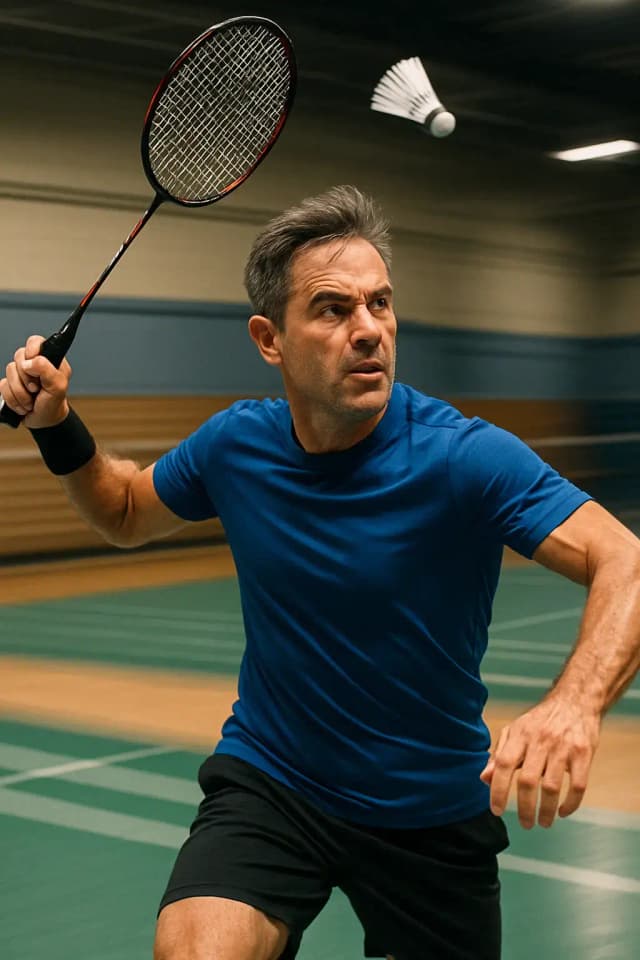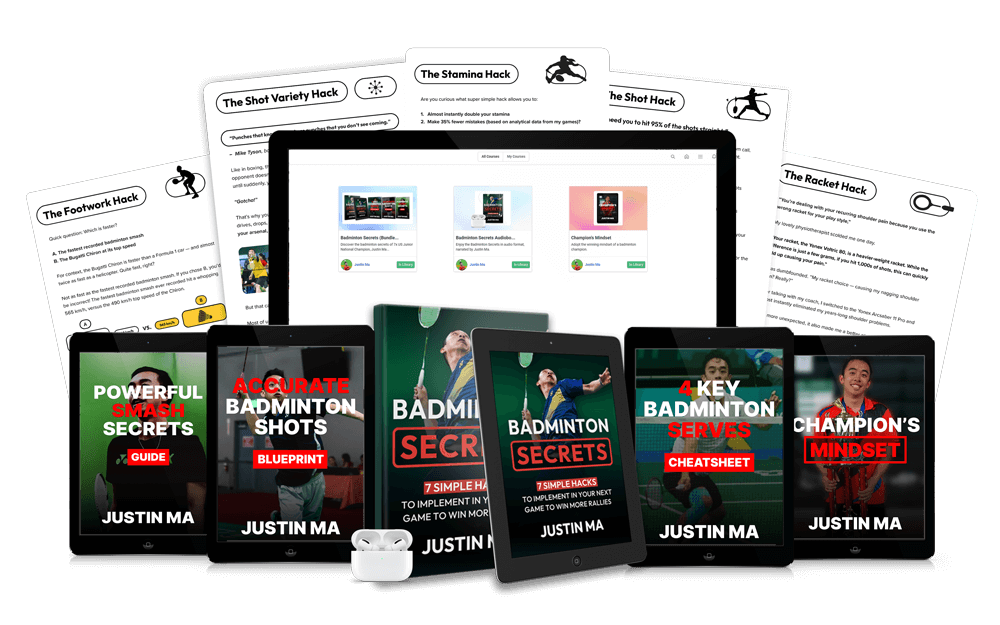By Justin Ma, 7x US Junior National Badminton Champion.
Last updated January 14, 2021
·
6 min read

When you’re learning how to play badminton step by step, serving is almost always going to be step one. The serve is indisputably the most important shot of the game. It sets the tone for the rally, and the badminton match itself. A player who can continuously be in control of the badminton serve during their game can out-score an opponent, even if they are not quite as skilled. Controlling the serve is controlling the game.
There are several distinct serving techniques in badminton, and knowing how and when to implement them is key to improving your game. Below we’re going to go from basics to more technical skills to set you on the path to perfect serves.
The first thing to understand when learning how to serve in badminton is to go back to basic badminton skills: the rules! BWF has specifically outlined badminton service rules that every player must follow. Losing a rally, and handing serving rights over to your opponent is frustrating. Doing so because you forgot about a rule and committed a service fault is even more frustrating. Service fault disputes are common occurrences, so understanding the badminton serving rules is one of the first ways to teach badminton to beginners.
We’re going to try to break down some of those badminton rules here for you!
#1. Neither side can cause an undue delay during service. This includes pausing between the backswing and forward motion of the racket to throw off your opponent’s timing. (See exact verbiage in rules 9.1.1, and 9.1.2.)
#2. The server and receiver shall stand in diagonally opposite service courts without touching boundary lines. If the server has scored an even number of points, players stand in their respective right service court. If the server has scored an odd number of points, players stand in their respective left service courts. (9.1.3, 10.1.1, 10.1.2)
#3. Some part of both of the servers feet must remain touching the court in a stationary position until the serve has been delivered. (9.1.4)
#4. The server’s racket must initially hit the head of the shuttle, and at the time of contact, the shaft and head of the racket must be pointed in a downward direction (See diagram A). (9.1.5, 9.1.7)

Diagram A
#5. The shuttle must be below the server’s waist at the instant of being hit. (9.1.6)
#6. If the server wins the rally, they get a point and serve again. If the receiver wins the rally, they get a point and become the server. (10.3.1., 10.2.1)
#7. The shuttle must travel over the net, without getting caught in it, and shall land within the boundaries of the receivers court. If the shuttle lands ON the service line, it is considered ?in?. (9.1.9, 13.2)
Some other quick rules: If you miss the shuttle when trying to serve, it’s obviously a fault. You also cannot serve until the receiver is ready. If you serve and your opponent attempts to hit your serve, they are then considered to have been ‘ready’, and cannot argue otherwise.
Fun fact: The S-Serve used to be a tricky serve that was almost impossible to return. It’s been banned in international competition, but to read up on it, check out our post on badminton scandals and controversies!
This is a trick question. The best badminton serve technique is really dependent on several factors:

The high serve – sometimes referred to as a long serve – is often an underhand/forehand serve that arcs high and lands deep in the back of the opponent’s court. It forces your opponent quickly backward and creates significant distance between the server and the receiver’s point of impact. This distance then weakens their return shot. It’s virtually impossible to deliver a powerful smash from the back of the court. Though it takes some skill to consistently hit the shuttle to the rear of the court without hitting it ?out?, this badminton serve is the one most beginners start out with.
This serve is a good idea for beginners because it allows them time to reset as their opponent races back to the rear of their court. The server can be highly prepared to return the next shot. The high serve is more likely to be seen in a singles game, but is also sometimes used in doubles.
You can use a high serve to your advantage if you take note of your opponent’s racket hand, and force them to use their backhand swing to return your serve. For example, if your opponent is right-handed, and you hit the shuttle deep into the left rear of the court, the receiver will be forced to use a backhand stroke to return it, further weakening their shot.
During a high serve, your non-racket foot is typically placed forward. This allows you greater swinging action, and an ability to rotate your body.
Check out this tutorial video on high serve techniques in badminton!
The Low Serve – sometimes referred to as a short serve – is a little trickier than the high serve. This underarm backhand serve sets the shuttle on a path to travel just over the net, as well as the front service line of the opponent’s court. This forces your opponent to rush to the net to return the serve, and hopefully send it high. This sets you up to smash a return at your opponent before they’re able to properly reset at center court.
The low serve is a slightly more risky approach than the high serve, and not always recommended for beginners because of the number of ways it can go wrong. Send the shuttle too low and it could potentially become tangled in the net. Send the shuttle a bit too high over the net, and your opponent is perfectly set to smash it back to you in an attack that ends the rally – and not in your favor! Remember to keep your racket head angled downward.
During a low serve, your racket foot is typically placed forward. It’s a more natural feeling. Not as much body rotation is necessary with a low serve, as it’s typically a backhand swing.
Check out this tutorial video on low serve techniques in badminton!
The flick serve is as close to a trick shot as you’ll get when it comes to how to serve in badminton. It’s an attempt at disguising a your serving style. It? a backhand shot to fool the opponent into thinking a low – or short – serve is coming their way. But a flick of the wrist and a shuttle adjustment at the last minute add power to the serve and send it to the rear of the court. This change in what the receiver was anticipating forces them to shift momentum quickly.
That split second adjustment can often give you the advantage you need to gain a point on your serve because your opponent cannot get to the shuttle in time.
To pull off this tricky serve, you’ll need to have your eyes on your opponent, not the shuttlecock. You need to see their anticipation, their eyes, their poise, and determine if they truly believe you’re about to send a low serve just over the net. Though they aren’t allowed to move until your racket strikes the birdie, you should attempt to anticipate what direction they’ll be heading in.
Your feet will mimic the positioning you use for your low serve. This is because we want the opponent to think that a low serve is coming, and your body stance gives away your serve.
Check out this tutorial video on flick serve techniques in badminton!
This is a newly popular, but very dangerous type of service shot in badminton today. This is one of the more advanced skills in badminton serves, and isn’t for everyone. This type of serve really only does justice to the elite player. It’s a direct shot straight to the opponent’s body. This kind of approach is unusual and therefore likely to catch the receiver off-guard.
The drive serve can quickly backfire, because it can be returned as a powerful smash that arrives in your court so fast, you’re not ready to return the shot. Do not attempt a drive serve without plenty of practice.
Check out this tutorial video on drive serve techniques in badminton!
Get ready for my coveted perfect serve secret? *drumroll please*. The secret is: practice. Disappointed? Don’t be! Every skill in badminton comes with practice, intentional training, and repetition. Invest in a qualified coach. Learn what serving techniques work for you.
My personal style is often a backhand short serve. I try to position myself in the middle of the court, which lets me start a rally in an advantageous position. I choose the short serve because it is harder for an opponent to attack when returning a short serve. That central position allows me to get to their return shot a little quicker with proper badminton footwork. I switch this up occasionally, because predictability is a detriment to your game. Your opponent will be ready to return every serve if they know exactly what you’ll be doing. If you’re a beginner, practicing that short serve should be on your to-do list. Your badminton serve will improve with time, training, and game experience.
Check out our YouTube channel, and subscribe for more up-to-date tips and training drills to keep your badminton skills sharp!
